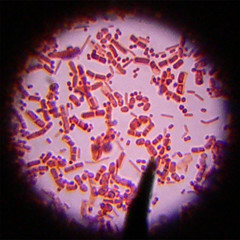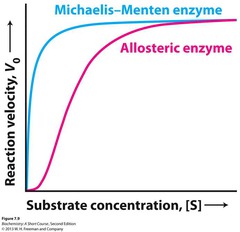| 105371404 | organelles | Prokaryotic cells are very small, and except for ribosomes, they do not have cytoplasmic ________. | |
| 105371405 | domain bacteria | metabolically diverse with some being heterotrophic by absorption, autotrophic by chemosynthesis or photosynthesis | |
| 105371406 | domain bacteria | motile forms move by flagella consisting of a single filament | |
| 105371407 | nitrogen fixed bacteria | (domain bacteria) aerobic heterotrophs that are important ecologically because they supply the world's organisms with fixed nitrogen for making proteins; live on leugunes | |
| 105371408 | decomposer bacteria | (domain bacteria) absorb nutrients from dead organisms and thus are important in the recycling of materials formerly part of other organisms | |
| 105371409 | pathogenic bacteria | (domain bacteria) cause disease | |
| 105371410 | bacillus-shaped | (domain bacteria, Pathogenic bacteria) Few selected diseases they cause: Bacillus (anthrax); Clostridium (tetanus, botulism, gas gangrene); Salmonella (typhoid fever, food poisoning): Mycobacterium (Tuberculosis, leprosy); Pseudomonas (pneumonia, burn infections); Chlamydia (most common STD in U.S.); Rickettsia (Rocky Mtn. spotted fever); E. Coli (traveler's diarrhea, food poisoning); Bordetella (whooping cought); Helicobacter (ulcers in stomach); Haemophilus (conjunctivitis/pinkeye); Yersina (plague) |  |
| 105371411 | Coccus-shaped | (domain bacteria, Pathogenic bacteria) Listed are a few selected genera and the diseases they cause: Staphylococcus (boils, skin infections, toxic shock syndrome); Streptococcus (stept throat, tooth cavities, flesh- eating bacteria, pneumonia); Neisseria (gonorrhea, meningitis); Vibrio (epidemic cholera). |  |
| 105371412 | Spirillum-shaped | (domain bacteria, pathogenic bacteria) Listed are a few selected genera and the diseases they cause: Tremponoma (syphilis); Borrelia (Lyme's diseases). | |
| 105371413 | Antibiotic producing bacteria | (domain bacteria) Streptomycin produces streptomycin | |
| 105371414 | Fermentation bacteria | (domain bacteria) anaerobic bacteria that utilized fermentation | |
| 105371415 | Cyanobacteria | (domain bacteria) these bacteria are ecologically important because they are photosynthetic using chlorophyll a (note: chlorophyll not contained in chloroplasts, but contained in thylakoids); contain phycocyanin (blue-green pigment) in addition to chlorophyll; can be unicellular or filamentous; some are nitrogen-fixing; contain gelatinous sheath. Examples: Nostoc, Oscillatoria and Anabaena (all filamentous) |  |
| 105371416 | domain Archaea | distinguishable from bacteria by their unique rRNA base sequence and their distinctive cell/plasma membrane and cell wall chemistry. | |
| 105371417 | methanogens | (Domain: Archaea) these release methane; live in swamps and sewage treatment plants and the guts of animals (cause flatulence). Essential to the ecology of the planet because swamp gas methane is converted to carbon dioxide, a major source of carbon for plants. Natural gas used for heating is 98% methane provided by ______ | |
| 105371418 | halophiles | Domain: Archaea- "salt loving"; Live in bodies of water with high concentrations of salt such as the Great Salt Lake in Utah and the Dead Sea in Mideast Asia | |
| 105371419 | Thermoacidophiles | Domain: Archaea- "heat and acid loving"; Live in hot sulphur springs such as the sulphur springs in Yellowstone National Park |  |
| 105371420 | domain eukarya | Eukaryotic, unicellular to multicellular organisms that have a membrane-bound nucleus containing several chromosomes. Sexual reproduction is common. Each kingdom has specializations that distinguish it from other kingdoms. | |
| 105371421 | kingdom fungi | (domain: eukarya): multicellular, eukaryotic, heterotrophic by absorption (saprotrophic), form nonmotile spores during both asexual and sexual reproduction as part of the haplontonic life cycle, lack flagella in all cycle stages | |
| 105371422 | lichens | (domain eukarya; kingdom: fungi) : a symbiotic relationship between a fungus and a cyanobacterium or a green algae |  |
| 105371423 | kingdom protista | (domain: Eukarya) - eukaryotic, unicellular organisms and their immediate multicellular descendents; most have sexual reproduction. Ex. Protozoans, amoebas, ciliates, zooflagellates, sporozoans, slime molds, algae | |
| 105371424 | fungi | Soil and dung molds, black bread molds, cup fungi, morels, truffles, yeast, powdery mildews, ergots, blights, mushrooms, puffballs, rusts, smuts, shelf fungi, bracket fungi, ringworm, athlete's foot are all examples of ______ |  |
| 105371425 | saprotrophic heterotrophs | Fungi are _____ ______ that is, they externally digest dead organic matter before absorbing the products. | |
| 105371426 | fungi | ____ have nonmotile spores that form during asexual and sexual reproduction | |
| 105371427 | hyphae | The body of most fungi are made of filaments called _____ . | |
| 105371428 | hypha | elongated cylinder containing mass of cytoplasm and hundreds of haploid (1N) nuclei; which may or may not be divided by cross walls | |
| 105371429 | mycelium | The body of a fungi is called the ____ . | |
| 105371430 | mycelium | The body of a fungi, a collection of hyphae. | |
| 105371431 | sporangium | a spore producing structure | |
| 105371432 | haplotonic | All fungi have the ____ life cycle. | |
| 105371433 | wind blown spores | Most fungi reproduce through the production of ____ ____ _____ on fruiting bodies. | |
| 105371434 | food vacuoles | formed by phacogytosis; pinches off of the plasma membrane and encloses a food particle | |
| 105371435 | contratile vacuoles | pushes excess water out in animal cells | |
| 105371436 | phylum rhizopoda | (Domain: Eukarya; Kingdom: Protista) "the amoebas" -40,000 species; ex. Amoeba
movement: extension of the cells | |
| 105371437 | phylum ciliophora | (Domain Eukarya; Kingdom Protista) "the ciliates" -8,000 species; ex. Paramecium
movement: swim with cilia | |
| 105371438 | phylum zoomastigophora | (Domain Eukarya; Kingdom Protista) "the zooflagellates" -thousands of species; ex. Trypanosoma (causes African sleeping sickness)
movement: whip-like flagella | |
| 105371439 | phylum apicomplexa | (Domain Eukarya; Kingdom Protista) "the sporozoans" -3,600 species; ex. pladmodium vivax (causes malaria)
movement: gliding | |
| 105371440 | plasmodium | the body of all slime molds (ex. physarum) | |
| 105371441 | physarum | a slime mold that demonstrates protoplasmic streaming; branches out to reproduce | |
| 105371442 | domain, kingdom, phylum, class, order, family, genus, species | List the eight taxonomic categories. (comma between each) | |
| 105371443 | domain | broadest category used to classify life forms (archaea, bacteria, fungi) | |
| 105371444 | kingdom | First and largest category used to classify organisms (fungi, protista, plantae, animalia) | |
| 105371445 | phylum | major classification, second to kingdom, of plants and animals; category ranking below a kingdom and above a class; division | |
| 105371446 | class | a taxonomic group containing one or more orders | |
| 105371447 | family | a taxonomic group containing one or more genera | |
| 105371448 | genus | Group of closely related species, and the first part of the scientific name in binomial nomenclature | |
| 105371449 | species | group of similar organisms that can breed and produce fertile offspring | |
| 105371450 | domain archaea | unique rRNA base sequence and distinctive cell/plasma membrane and cell wall chemistry; many are autotrophic by chemosynthesis; some are heterotrophic by absorption, represent some of the most primitive life forms on earth and live in extreme environments |  |
| 105371451 | domain bacteria | metabolically diverse with some being heterotrophic by absorption; autotrophic by chemosynthesis or photosynthesis. Motile forms move by flagella consisting of a single filament. | |
| 105371452 | domain eukarya | eukaryotic, unicellular to multicellular organisms that have a membrane-bounded nucleus containing several chromosomes; sexual reproduction is common. | |
| 105371453 | kingdom fungi | multicellular; eukaryotic; heterotrophic by absorption; form nonmotile spores during both sexual reproduction as part of the haplotonic life cycle; lack flagella in all life cycle stages | |
| 105371454 | kingdom protista | eukaryotic; unicellular; not animals but they are animal like | |
| 105371455 | kingdom plantae | multicelluar; eukaryotic; photosynthetic; embryo is protected from drying out; have the alternation of generations life cycle | |
| 105371456 | kingdom animalia | Aerobic, multicellular, heterotrophic by ingestion, no cell walls, motile through cytoskeletal motors, taxonomic kingdom comprising all living or extinct animals | |
| 105371457 | prokaryotes | Domain Bacteria and Domain Archaea are the ________ ., organisms that lack a membrane-bound nucleus and membrane-bound organelles | |
| 105371458 | domain archaea | methogens, halpophiles and thermoacidophiles are all representative groups and examples of ________ |  |
| 105371459 | Carolus Linnaeus | (1750) Swedish botanist who developed a taxonomic scheme to name animals called the "binomial nomenclature" |  |
| 105371460 | binomial nomenclature | a system for giving each organism a two-word scientific name that consists of the genus name followed by the species name | |
| 105371461 | John Ray | (1700) A 17th Century Christian botanist who was the first to use the term "species," a group of similarly constructed organisms capable of interbreeding and producing fertile offspring | |
| 105371462 | eukaryotes | organisms made up of one or more cells that have a nucleus and membrane-bound organelles | |
| 105371463 | Louis Pasteur | French chemist and biologist whose discovery that fermentation is caused by microorganisms resulted in the process of pasteurization (1822-1895) | |
| 105579907 | protozoans | animal-like protists | |
| 105579908 | slime molds | a broad term describing fungus-like organisms that use spores to reproduce; feed on microorganisms that live in any type of dead plant material |  |
| 105622727 | anabaena | Cyanobacteria, Haploid-spiral | |
| 105622728 | oscillatoria | long filament of cells; photoautotrophs; cyanobacteria | |
| 105622729 | xylem | the vascular tissue through which water and nutrients move in some plants | |
| 105622730 | phloem | vascular tissue responsible for the transport of nutrients and the carbohydrates produced by photosynthesis | |
| 105622731 | sporangium | spore capsule in which haploid spores are produced by meiosis | |
| 105622732 | sepal | A modified leaf in angiosperms that helps enclose and protect a flower bud before it opens. | |
| 105622733 | filament | a long, thin structure that supports an anther | |
| 105622734 | pistil | the female ovule-bearing part of a flower composed of ovary and style and stigma | |
| 105622735 | stigma | the apical end of the style where deposited pollen enters the pistil | |
| 105622736 | style | the narrow elongated part of the pistil between the ovary and the stigma | |
| 105622737 | ovary | the organ that bears the ovules of a flower | |
| 105622738 | flagellum | a long, whiplike structure that helps a cell to move | |
| 105622739 | phagocytosis | process in which extensions of cytoplasm surround and engulf large particles and take them into the cell | |






































